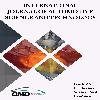Design and Modeling of an Impulse Continuously Variable Transmission with a Rotational Swashplate
A novel mechanical impulse continuously variable transmission (ICVT) is developed to provide continuously variable speed ratios and smooth acceleration for drivetrains based on a rotational swashplate, and its design principle is illustrated. A swashplate-guide linkage mechanism is used in the ICVT; the speed ratio of the ICVT is changed with the swirl angle of the rotational swashplate. A slider–linkage system, whose mo-tion is controlled by a speed-regulating handle, is used to adjust the swirl angle of the swashplate. A planetary gear system converts the regulated rotational speed of the swashplate to the output shaft of the ICVT. The speed range of the ICVT can be scaled up by coupling planetary gear sys-tems with different speed ratios. Overrunning clutches are used to rectify the rotational speed from the swashplate-guide linkage mechanism to ob-tain the output speed of the ICVT. Since the rotational swashplate can in-troduce large impulse rates of the instantaneous speed ratio, a connecting linkage is used to reduce the impulse rate and unbalanced inertial forces of the ICVT. Experimental tests of the output speed of the ICVT with four guide linkages verify the feasibility of the design and operation perfor-mance of the ICVT.
___
- Wang, X. F., and Zhu, W. D. (2018). Design and stability analysis of an integral time-delay feedback control combined with an open-loop control for an infinitely variable transmission system. ASME Journal of Dynamic Systems, Measurement, and Control, 140(1), p. 011007.
- Wang, X. F., and Zhu, W. D. (2016). Design, modeling, and experimental validation of a novel infinitely variable transmission based on scotch yoke systems. ASME Journal of Mechanical Design, 138(1), p. 015001.
- Ross, M. (1997). Fuel efficiency and the physics of automobiles. Contemporary Physics, 38(6), 381-394.
- Manwell, J. F., McGowan, J. G., and Rogers, A. L. (2010). Wind Energy Explained: Theory, Design and Application, John Wiley & Sons.
- Yan, J., Li, G., and Liu K. (2020). Development trend of wind power technology. International Journal of Advanced Engineering Research and Science, 7(6), 124-132.
- Rupp, D., and Guzzella, L. (2010). Adaptive internal model control with application to fueling control. Control Engineering Practice, 18(8), 873-881.
- Sun, Z. X., and Hebbale, K. (2005). Challenges and opportunities in automotive transmission control. Proceedings of the 2005 American Control Conference, Portland, 3284-3289.
- Kulkarni, M., Shim, T., and Zhang, Y. (2007). Shift dynamics and control of dual-clutch transmissions. Mechanism and Machine Theory, 42(2), 168-182.
- Srivastava, N., and Haque, I. (2009). A review on belt and chain continuously variable transmissions (CVT): Dynamics and control. Mechanism and Machine Theory, 44(1), 19-41.
- Hu, Y. H., Li, G., Zhu, W.D., and Cui, J. K. An elastic transmission error compensation method for rotary vector speed reducers based on error sensitivity analysis. Applied Sciences, 10(2), 481.
- Pner, R., Guzzella, L., and Onder, C. (2003). Fuel-optimal control of CVT powertrains. Control Engineering Practice, 11(3), 329-336.
- Zhu, C., Liu, H., Tian, J., Xiao, Q., and Du, X. (2010). Experimental investigation on the efficiency of the pulley-drive CVT, International Journal of Automotive Technology, 11(2), 257-261.
- Savaresi, S. M., Taroni, F. L., Previdi, F., and Bittanti, S. (2004). Control system design on a power-split CVT for high-power agricultural tractors. IEEE/ASME Transactions on Mechatronics, 9(3), 569-579.
- van Berkel, K., Hofman, T., Vroemen, B., and Steinbuch, M. (2012). Optimal control of a mechanical hybrid powertrain. IEEE Transactions on Vehicular Technology, 61(2), 485-497.
- Pesgens, M., Vroemen, B., Stouten, B., Veldpaus, F., and Steinbuch, M. (2006). Control of a hydraulically actuated continuously variable transmission. Vehicle System Dynamics, 44(5), 387-406.
- Setlur, P., Wagner, J. R., Dawson, D. M., and Samuels, B. (2003). Nonlinear control of a continuously variable transmission (CVT). IEEE Transactions on Control Systems Technology, 11(1), 101-108.
- Ruan, Z. T. (1999). Design and Selecting Guidelines of Mechanical Continuous Variable Transmission. Beijing: Chemical Industry Press.
- GUSA. (1988). Variable Speed Gear Drive. Heinrich Gens-heimer & Sohne co.
- Zhou, Y. Q. (2001). Mechanical Continuous Variable Transmission. Beijing: China Machine Press.
- Zhou, Y. Q., Cui, X. L., and Dong, Z. F. (2005). Introduction and development of mechanical variable speed drives. Journal of Mechanical Transmission, 29 (1): 65-68.
- Kazem, K., and Zoltan, F. S. (2005). Parallel disk continuously variable transmission (PDCVT). Mechanism and Machine Theory, 40 (9): 1-30.
- Ruan, Z. T. (1999). Mechanical Continuous Variable Transmission. Beijing: China Machine Press.
- Zhu, Y., and Liu, K. C. (2003). The present situation of research and development of impulse stepless speed variator. Packaging and Food Machinery, 21 (5): 11-14.
- Li, G., Wang, Z. H., and Zhu, W. D., (2019). Prediction of surface wear of involute gears based on a modified fractal method. ASME Journal of Tribology, 141(3), 031603.
- Yayın Aralığı: Yılda 4 Sayı
- Başlangıç: 2016
- Yayıncı: Otomotiv Mühendisleri Derneği
